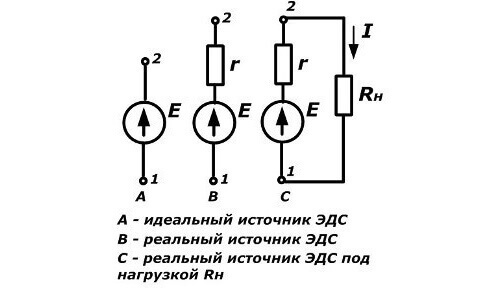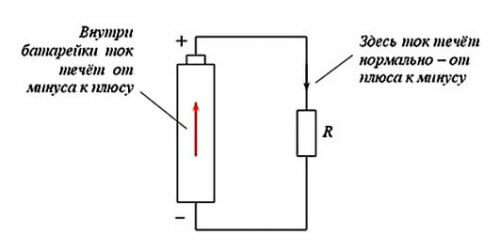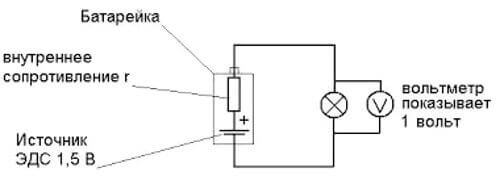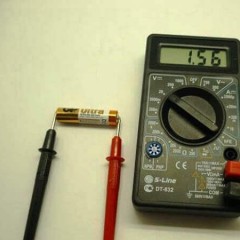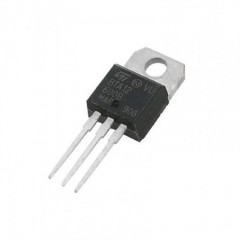What is the difference between EMF and voltage: a simple explanation on the example
What is electromotive force
We examined this issue in detail in a separate article:https://my.electricianexp.com/en/chto-takoe-eds-obyasnenie-prostymi-slovami.html
EMF is understood as a physical quantity characterizing the operation of any external forces located in power sources direct or alternating current. Moreover, if there is a closed circuit, then we can say that the EMF is equal to the work of forces in moving a positive charge to a negative in a closed circuit. Or in simple words, the EMF of a current source represents the work needed to move a unit charge between the poles.
Moreover, if the current source has infinite power, and there is no internal resistance (position A in the figure), then the EMF can be calculated from Ohm's law for the chain sectionbecause voltage and electromotive force in this case are equal.
I = U / R,
where U is the voltage, and in the considered example is the EMF.
However, a real power supply has a finite internal resistance. Therefore, such a calculation cannot be applied in practice. In this case, to determine the EMF use the formula for the complete circuit.
I = E / (R + r),
where E (also referred to as "ԑ") is the EMF; R is the load resistance, r is the internal resistance of the power source, I is the current in the circuit.
However, this formula does not take into account the resistance of the circuit conductors. It is necessary to understand that inside the DC source and in the external circuit, the current flows in different directions. The difference lies in the fact that inside the element it flows from minus to plus, then in the external circuit from plus to minus.
This is clearly illustrated in the figure below:
In this case, the electromotive force is measured with a voltmeter, in the case when there is no load, i.e. The power source is idling.
To find the EMF through the voltage and load resistance, you need to find the internal resistance of the power source, for this measure the voltage twice at different load currents, and then find the internal resistance. Below is the calculation procedure by formulas, then R1, R2 are the load resistance for the first and second measurements, respectively, the remaining values are similar, U1, U2 are the source voltage at its terminals under load.
So, we know the current, then it is equal to:
I1 = E / (R1 + r)
I2 = E / (R2 + r)
Wherein:
R1 = U1 / I1
R2 = U2 / I2
If we substitute in the first equations, then:
I1 = E / ((U1 / I1) + r)
I2 = E / ((U2 / I2) + r)
Now we divide the left and right parts into each other:
(I1 / I2) = [E / ((U1 / I1) + r)] / [E / ((U2 / I2) + r)]
After calculating the resistance of the current source, we get:
r = (U1-U2) / (I1-I2)
Internal resistance r:
r = (U1 + U2) / I,
where U1, U2 is the voltage at the source terminals at different load currents, I is the current in the circuit.
Then the EMF is:
E = I * (R + r) or E = U1 + I1 * r
What is voltage
Electric voltage (denoted as U) is a physical quantity that reflects the quantitative characteristic of the electric field in transferring charge from point A to point B. Accordingly, the voltage can be between two points of the circuit, but unlike the EMF, it can be between two conclusions of which one of the elements of the chain. Recall that the EMF characterizes the work performed by external forces, that is, the work of the current source or EMF to transfer charge through the entire circuit, and not on a specific element.
This definition can be expressed in simple language. The voltage of direct current sources is the force that moves free electrons from one atom to another in a certain direction.
For alternating current, the following concepts are used:
- instantaneous voltage is the potential difference between points in a given period of time;
- amplitude value - represents the maximum value modulo the instantaneous voltage value over a period of time;
- the average value is the constant component of the voltage;
- RMS and RMS.
The voltage of the circuit depends on the material of the conductor, the load resistance and temperature. Like electromotive force is measured in Volts.
Often, to understand the physical meaning of stress, it is compared to a water tower. The water column is identified with voltage, and the flow with current.
At the same time, the column of water in the tower gradually decreases, which characterizes a decrease in voltage and a decrease in current strength.
So what is the difference
For a better understanding of what the difference in electromotive force from voltage is, consider an example. There is a source of electric energy of infinite power, in which there is no internal resistance. A load is mounted in the electrical circuit. In this case, it will be true that EMF and voltage are identically equal, i.e. there is no difference between these concepts.
However, these are ideal conditions that do not occur in real life. These conditions are used exclusively in the calculations. In real life, the internal resistance of the power source is taken into account. In this case, the EMF and voltage are different.
The figure shows what the difference will be in the values of the electromotive force and voltage in real conditions. The above formula for Ohm's law for a complete chain describes all processes. With an open circuit, the battery terminals will be 1.5 Volts. This is the value of EMF. By connecting the load, in this case it is a bulb, it will have a voltage of 1 volt.
The difference from an ideal source is the internal resistance of the power source. At this resistance, a voltage drop occurs. These processes are described by Ohm's law for a complete chain.
If the measuring device at the terminals of the electric power source shows a value of 1.5 Volts, this will be an electromotive force, but we will repeat, provided there is no load.
When connecting the load, the terminals will have a clearly lower value. This is the tension.
Conclusion
From the above, we can conclude that the main difference between the EMF and the voltage is:
- The electromotive force depends on the power source, and the voltage depends on the connected load and the current flowing through the circuit.
- Electromotive force is a physical quantity that characterizes the work of external forces of non-electric origin occurring in DC and AC circuits.
- Voltage and EMF has a single unit of measurement - Volt.
- U is a physical quantity equal to the work of the effective electric field produced when a unit test charge is transferred from point A to point B.
Thus, briefly, if U is represented as a column of water, then EMF can be imagined that it is a pump that maintains a constant water level. We hope that after reading the article you will understand the main difference!
Related materials:

